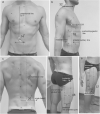A new approach to quantify visceral fat via bioelectrical impedance analysis and ultrasound compared to MRI
- PMID: 37891402
- PMCID: PMC10824659
- DOI: 10.1038/s41366-023-01400-7
A new approach to quantify visceral fat via bioelectrical impedance analysis and ultrasound compared to MRI
Abstract
Background: Visceral adipose tissue (VAT) has been linked to systemic proinflammatory characteristics, and measuring it accurately usually requires sophisticated instruments. This study aimed to estimate VAT applying a simpler method that uses total subcutaneous fat and total body fat (BF) measurements.
Method: As part of our experimental approach, the subcutaneous fat mass (SFT) was measured via US (SFTtotal), and VAT was quantified by assessing MRI data. Both parameters were added to obtain total body fat (BFcalc). Those results were then compared to values obtained from a bioelectrical impedance analysis (BFBIA). Multiple regression analyses were employed to develop a simplified sex-specific equation for SFT, which was subsequently used in conjunction with BFBIA to determine VAT (VATEq).
Result: We observed excellent reliability between BFBIA and BFcalc, with no significant difference in body fat values (20.98 ± 8.36 kg vs. 21.08 ± 8.81 kg, p = 0.798, ICC 0.948). VATEq_female/male revealed excellent reliability when compared to VATMRI, and no significant difference appeared (women: 0.03 ± 0.66 kg with a 95% CI ranging from -1.26 kg to 1.32 kg, p = 0.815, ICC: 0.955.; men: -0.01 ± 0.85 kg with a 95% CI ranging from -1.69 kg to 1.66 kg, p = 0.925, ICC: 0.952).
Conclusion: Taking an experimental approach, VAT can be determined without MRI.
© 2023. The Author(s).
Conflict of interest statement
The authors declare no competing interests.
Figures




References
-
- Ladeiras-Lopes R, Sampaio F, Bettencourt N, Fontes-Carvalho R, Ferreira N, Leite-Moreira A, et al. The ratio between visceral and subcutaneous abdominal fat assessed by computed tomography is an independent predictor of mortality and cardiac events. Revista Espanola de Cardiologia. 2017;70:331–7. doi: 10.1016/j.rec.2016.09.010. - DOI - PubMed
MeSH terms
LinkOut - more resources
Full Text Sources
Research Materials
Miscellaneous

